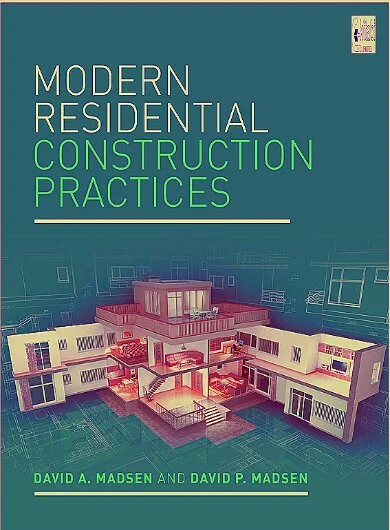Modern Residential Construction Practices- PDF for free

Want a home that’s good for you and the planet? Home building is changing fast! New tech and green ideas are making homes better than ever. This book will explore the ways modern construction is changing how we build houses.
Sustainable Building Materials and Techniques
Want to build green? It’s about using materials and ways to build that help the Earth. These choices cut down on waste and energy use.
Environmentally Friendly Material Options
Think about bamboo. It grows fast! Reclaimed wood? That’s old wood made new. Recycled steel and special concrete are also great choices. Bamboo is strong but needs care in wet places. Reclaimed wood looks cool but can cost more. Recycled steel is tough. This green concrete cuts down on pollution when made.
Passive House Design Principles
Passive design is cool. It uses the sun and wind to heat and cool your home. Super thick walls keep heat in during winter. Smart window placement lets the sun warm rooms. Good seals keep air from leaking out. All this cuts way down on energy bills.
Green Roofing Systems
Green roofs are roofs with plants on them. They help keep your house cool in summer and warm in winter. Rain soaks into the soil instead of running off. Plus, they make a nice home for bugs and birds. They look pretty too!
Technological Advancements in Home Construction
New tech is speeding up building. It also makes homes more precise and easier to manage.
Building Information Modeling (BIM)
BIM is like a 3D model of your house on a computer. It lets architects, builders, and plumbers all see the same plan. They can spot problems before building starts! This cuts down on mistakes and saves money.
Modular and Prefabricated Construction
Think of LEGOs for houses. Parts of your house are built in a factory. Then they’re shipped to your lot and put together. It’s much faster than building from scratch! This can also save you money on labor.
Smart Home Integration
Want to control your lights with your phone? Smart homes let you do that and more. You can adjust the temperature, lock doors, and even water the lawn from anywhere. It makes life easier and saves energy.
Energy Efficiency and Smart Home Technology
Saving energy is a big deal today. Smart tech and good building practices make it easier.
Advanced Insulation Techniques
Good insulation keeps your house cozy. Spray foam fills every crack. Insulated concrete forms (ICFs) and structural insulated panels (SIPs) make walls super strong and energy-efficient. These methods trap heat inside during cold weather and keeps it out when it is hot.
Solar Panel Integration and Energy Storage
Solar panels turn sunlight into power. You can put them on your roof and save money on electricity. Batteries store extra power for when the sun isn’t shining. Some designs seamlessly incorporate the panels into the roof.
Smart Thermostats and Energy Monitoring Systems
Smart thermostats learn your habits. They adjust the temperature to save energy when you’re not home. Energy monitors show you how much power you’re using. This helps you find ways to cut back.
Addressing Labor Shortages and Skill Gaps
There aren’t enough skilled workers. This is a problem for the construction industry. Training and new tech can help.
Automation and Robotics in Construction
Robots can do some jobs on building sites. They can lay bricks, weld metal, and even put up drywall. This frees up workers to do more skilled tasks.
Virtual Reality (VR) and Augmented Reality (AR) Training
VR and AR can train workers without real risks. They can practice tricky jobs in a safe, computer-made space. This helps them learn faster and better.
Investing in Workforce Development Programs
Schools and companies can work together. They can offer training and apprenticeships. This helps people learn the skills they need to get good jobs.
Design Trends and Customization Options
Today’s homes are all about you. It’s about making a space that fits your life.
Open-Concept Living Spaces
Open layouts make rooms feel bigger. They’re great for parties and families. Lots of light flows through the space. Everything connects easily.
Aging-in-Place Design Principles
Homes can be made for everyone. Wider doorways and ramps help people who use wheelchairs or walkers. Grab bars in bathrooms add safety. Easy-to-reach shelves make life simpler for everyone, no matter their abilities.
Incorporating Biophilic Design Elements
Bring the outdoors in! Use natural materials like wood and stone. Add plants to every room. Make sure you can see the sky and trees from inside.
Regulatory Compliance and Building Codes
Rules keep us safe. Building codes make sure homes are well-built.
Understanding Energy Codes and Standards
Energy codes set rules for how much energy a home can use. Following these rules makes homes more efficient. LEED is a system that awards points for green building.
Fire Safety Regulations and Prevention Measures
Fire-resistant materials help slow down fires. Sprinkler systems put out fires quickly. Smoke alarms warn you when there’s a fire.
Permitting and Inspection Processes
You need a permit to build a house. Inspectors check the work to make sure it’s safe. This protects you and your neighbors.
Conclusion
Modern residential construction is about building better homes. We use green materials, new tech, and smart designs. These changes help homeowners, builders, and the Earth. Expect even more exciting innovations in the future!
